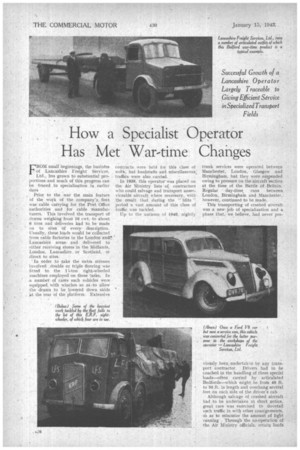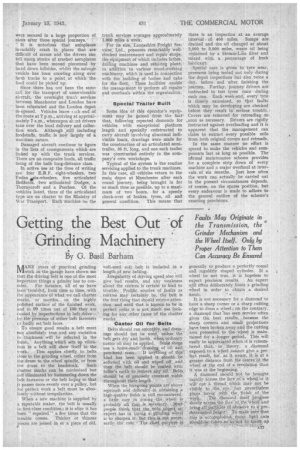, How a Specialist Operator Has Met War-time Chafiges
Page 28

Page 29

If you've noticed an error in this article please click here to report it so we can fix it.
Successful Growth of a Lancashire Operator. Largely Traceable to Giving Efficient Service in Specialized Transport
Fields
FROM small beginnings, the business of Lancashire Freight Services, Ltd., has grown to substantial proportions and much of this progress can be -traced to specialization in earlier days Prior. to the war the main feature of the work of the company's, fleet was cable carrying for the Post Office authorities and for cable manufacturers. This involved the transport of drums weighing from 10 cwt. to about 6 tons and deliveries had to be made on to sites of every description_ Usually, these loads would be collected from cable factories in the London and Lancashire areas. and delivered to either receiving stores in the Midlands, London, Lancashire. or Scotland, or direct to sites.
' In order to -take the extra stresses involved . double or triple flooring was fitted to the li-ton sight-wheeled machines employed on theke tasks. In -a number of cases such vehicles were equipped, with winches so as to allow the drums to be., lowered down skids at the rear of the platform. Extensive contracts were held for this class of wthis, but foodstuffs and miscellaneous; traffics were also carried.
. In 1939, this operator' was placed on the Air Ministry lists of contractors who could salvage and transport unserviceable aircraft. where necessary, with the result that during the " blitz " _period a vast amount of this class of traffic was tackled, Up to the autumn of 1940, nightly trunk services were operated between Manchester, London, Glaagow and Birmingham, but they were suspended owing to pressure on the aircraft section at the time of the. Battle of Britain. • Regular day-time, runs between London, Birmingham arid Manchester, however, continued to be Made, This transporting of crashed aircraft was a new job of specialization and a phase that, we believe, had never pre_
viously been undertakeit by any transport contractor. Drivers had to be coached in the handling of these special loads—often carried by articulated Bedfords—which might be from 40 ft. to 50 ft. in -length and overhang several feet on each side of the driver's cab
Although salvage of crashed aircraft had to be undertaken at short notice, great care was exercised to dovetail such traffic in with other consignments, sb as to minimize the amount pf light running Througl . the co-operation of the Air Ministry officials, return loads were secured in a large proportion of cases after these special journeys.
` It is notorious that aeroplanes invariably crash in places that are difficult of access and the drivers can tell many stories of crashed aeroplanes that have been moved piecemeal by hand down hillsides, whilst the salvage vehicle has been crawling along over farm tracks to a point at which the load could be picked up. • Since there has not been the same call for the transport of unserviceable aircraft, the overnight trun'c services between Manchester and London have been reinstated and the London depot re-opened. Vehicles leave csch end of the route at 7 p.m., arriving at approximately 7 a.m., whereupon slInt drivers take over the local delivery and collec tion work. Although including foodstuffs, traffic is now largely of a war-time nature.
Damaged aircraft continue to figure in the lists of consignments which -are linked up with the trunk services. There are no composite loads, all traffic being of the bulk long-distance class.
In active use at the time of writing are four E.R.F. eight-wheelers, two Foden osix-wheelers, five articulated Bedford-a, two articulated Dodges, a Thorny-croft and a Peerless. Of the vehicles listed, three of the articulated type are on charter to the Ministry of %Var. Transport. Each machine on the
trunk services averages approximately 1000 miles a week. • For its size; Lancashire Freight Services, Ltd., possesses remarkably well' stocked maintenance and repair shops, the equipment of which includes lathes, drilling machines and reboring plant: • in addition to various wood-working machinery, which is used in connection with the building of bodies and cabs for the fleet. These facilities enable the management to perform all repairs and overhauls within the organization.
Special Trailer Built ' • Some idea of this Operator's equipment may be gained from the fact' that, following repeated demands for vehicles with exceptional platform length and specially coffstructed to carry aircraft involving abnormal indivisible loads, drawings were made for the construction of an articulated semitrailer, 35 ft. long, and one such trailer was constructed entirely in the company's own workshops.
Typical of the system is the routine servicing applied to the trunk machines. In this' case, all vehicles return to the main depot at Manchester after each round journey, being brought in for -as much time as possible, up to a Maximum of two hours, for a speedy check-over of brakes, tyres, oil and general condition. This means ' that
there is an inspection at an average interval of 400 miles. Sumps are drained and the oil changed at about 2,000 to 3,000 miles, waste oil being reclaimed by a Stream-Liiie filter and mixed with a percentage of fresh lubricant.
Special care is given to • tyre wear, pressures being tested. not only during the depot inspections but also twice a day, before and afterfinishing the journey. Further, journey drivers are instructed to test tyres once during each run. Each week-end, every tyre is closely examined, so that faults which may be developing are checked before they result in serious trouble.. Covers are removed for retreading so „soon as necessary. Drivers are rigidly instructed against overloading and it is apparent that the management can claim to extract every possible mile from both original covers and retreads.
In the same manner no effort is spared to make the vehicles and components last as long as possible. The nbrmal maintenance scheme provides . for a complete strip down of every machine and a major overhaul at intervals of six months. Just how often the work can actually be carried out in the present circumstances depends, of course, on the spares position, but every endeavour is made to adhere to the general outline of the scheme's exacting provisions.




















































